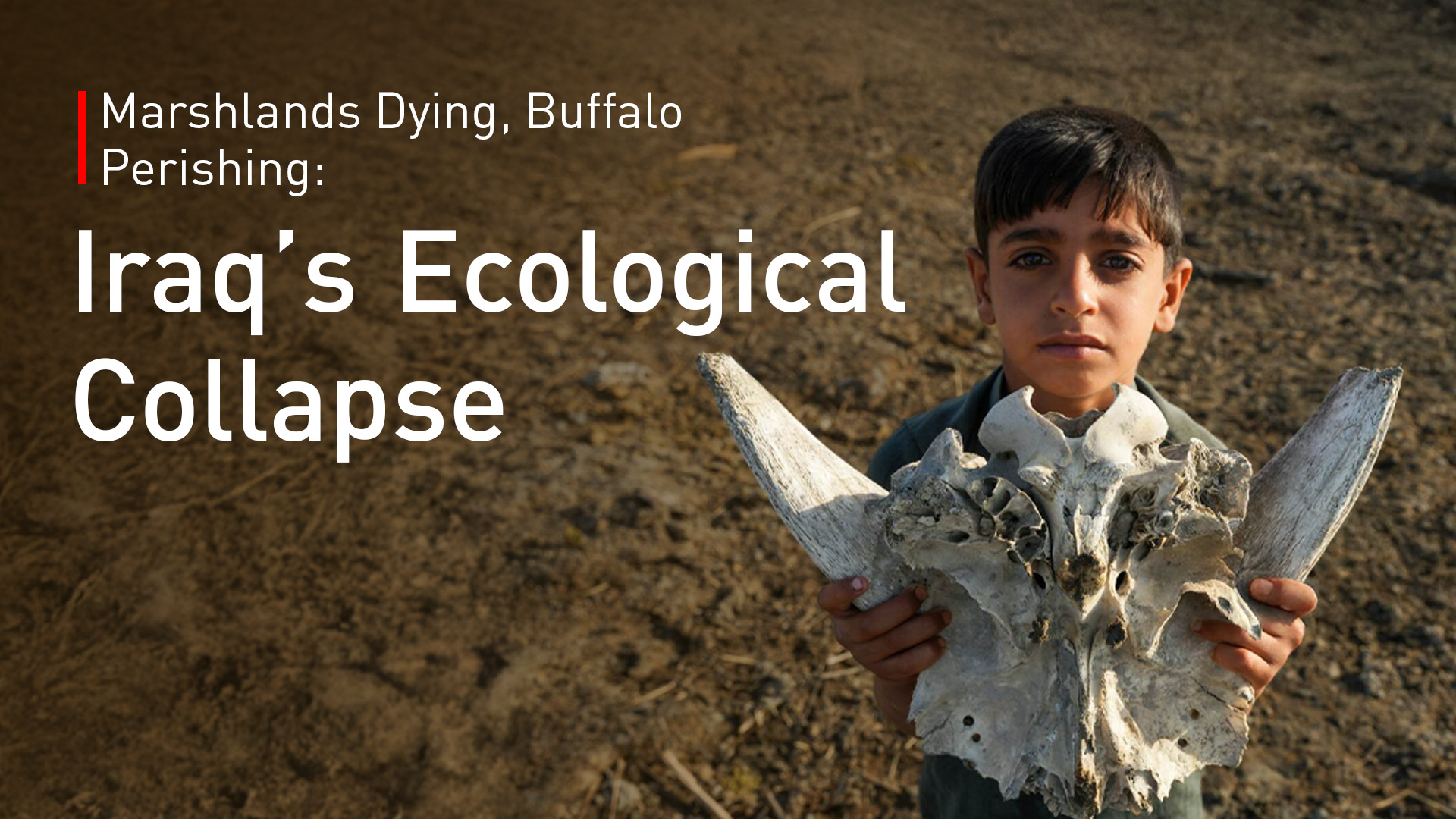Buffalo Die-Off, Drought Devastate Iraq’s Famed Marshes
The salinity and water scarcity have devastated local ecosystems, leading to the mass death of buffalo herds, a sharp decline in fish stocks, and the near-total cessation of agriculture.

By Kamaran Aziz
ERBIL (Kurdistan24) – Once revered as one of Iraq’s most stunning natural landscapes, the Umm al-Wada’ Marshes in southern Iraq are now on the brink of ecological collapse. Despite their status as a UNESCO World Heritage Site, the marshes—part of the legendary Mesopotamian wetlands—are withering under the combined weight of drought, climate change, regional water politics, and human negligence.
In recent months, local communities have witnessed a humanitarian and environmental catastrophe unfold before their eyes. Water levels have receded to perilously shallow channels sustained only by saline runoff from a main outfall canal. The salinity and water scarcity have devastated local ecosystems, leading to the mass death of buffalo herds, a sharp decline in fish stocks, and the near-total cessation of agriculture.
“Our livestock have suffered greatly from disease,” said Naeem Ali, a resident of the marshes, speaking to Kurdistan24. “We receive no veterinary support, no vaccines, and no treatment.”
Another villager, Maseer al-Fartousi, lamented the impact on their way of life: “Since the drought began, we’ve suffered immense losses—beyond calculation.”
The current crisis has triggered a rescue initiative organized by the Green Climate Organization in coordination with local partners. The effort includes a three-month campaign to provide vaccinations, health screenings, and disease diagnostics for surviving livestock.
“This campaign, launched in cooperation with the Green Climate Organization, will include targeted veterinary support in the Umm al-Wada’ Marshes and surrounding areas,” said Dr. Asaad al-Mutairi, Executive Director of the Marshes Rescue Campaign.
Dr. Aya, a representative from the Green Climate Organization, added: “Our goal is not only to monitor and diagnose the spread of endemic diseases, but also to underscore the cultural and ecological significance of the marshes while aiding buffalo herders who have been left to fend for themselves.”
Yet, such localized efforts may not be enough. The current crisis highlights the need for broad and sustained action to rescue Iraq’s marshes from vanishing entirely. Once nourished by the spring floods of the Tigris and Euphrates rivers, the marshlands have long supported a semi-nomadic way of life that traces back millennia. But their steady decline began in the 1990s when Saddam Hussein’s regime deliberately drained the wetlands to flush out political dissidents, accusing the marsh inhabitants of collaborating with Iran during the war.
At their peak in the early 1990s, Iraq’s marshes covered nearly 20,000 square kilometers. Today, less than a quarter of that area—around 4,000 square kilometers—remains. This contraction has been exacerbated by climate change, which has reduced rainfall and increased evaporation, and by extensive dam construction in upstream countries such as Turkey and Iran. These dams have significantly curtailed the flow of water into Iraq, with the Tigris and Euphrates rivers seeing reductions of over 50 percent in some areas, according to regional water experts.
According to a March 2025 report by the UN Food and Agriculture Organization (FAO), up to 80 percent of Iraq’s southern marshlands in Dhi Qar province have dried up. The FAO and Iraq’s Ministry of Environment have warned that the drought is among the worst the region has seen in over four decades. Local sources have noted that marsh dwellers are being displaced in large numbers, with some 500,000 Iraqis forced to abandon their ancestral homes in the last five years alone due to climate-related pressures.
Meanwhile, pollution, including heavy metals from industrial and medical waste, continues to seep into remaining water channels. As reported by Baghdad University and environmental organizations like Nature Iraq, these contaminants pose grave public health risks, especially as water salinity rises and safe drinking water becomes scarce.
Iraq’s environmental degradation is further worsened by internal mismanagement. Experts such as water strategy advisor Dr. Ramazan Hamza have criticized the lack of coordinated water policy, insufficient investment in water-saving infrastructure, and outdated agricultural practices that continue to squander precious water resources. Hamza, along with other analysts, urges a shift to smart irrigation, dam renovation, and regional water diplomacy to avert total ecological collapse.
UNICEF and the Iraqi Directorate of Water recently marked World Water Day by warning that millions of Iraqis, especially children, are at risk due to unsafe drinking water. The World Bank estimates that Iraq will require over $233 billion in investments by 2040 to address climate resilience and infrastructure decay.
The fate of the Umm al-Wada’ Marshes is therefore more than a local tragedy—it is a bellwether of Iraq’s broader environmental breakdown. Without urgent and coordinated intervention at national and international levels, not only will a UNESCO-recognized ecosystem be lost, but a civilization rooted in the ancient Mesopotamian marshes may be erased forever.
Kurdistan24 Correspondent Haidar Hanoun from Nasiriyah contributed to this report.
